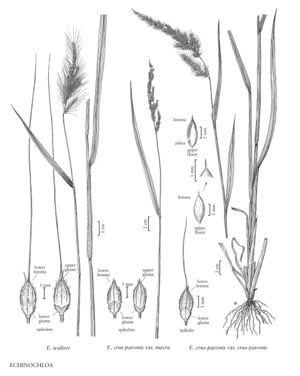Difference between revisions of "Echinochloa crus-pavonis var. crus-pavonis"
Treatment appears in FNA Volume 25. Treatment on page 398.
FNA>Volume Importer |
FNA>Volume Importer |
||
| Line 1: | Line 1: | ||
{{Treatment/ID | {{Treatment/ID | ||
|accepted_name=Echinochloa crus-pavonis var. crus-pavonis | |accepted_name=Echinochloa crus-pavonis var. crus-pavonis | ||
| − | |accepted_authority= | + | |accepted_authority= |
|publications= | |publications= | ||
|basionyms= | |basionyms= | ||
| Line 25: | Line 25: | ||
-->{{#Taxon: | -->{{#Taxon: | ||
name=Echinochloa crus-pavonis var. crus-pavonis | name=Echinochloa crus-pavonis var. crus-pavonis | ||
| − | + | |authority= | |
| − | |authority= | ||
|rank=variety | |rank=variety | ||
|parent rank=species | |parent rank=species | ||
| Line 32: | Line 31: | ||
|basionyms= | |basionyms= | ||
|family=Poaceae | |family=Poaceae | ||
| − | |illustrator=Linda A. Vorobik | + | |illustrator=Linda A. Vorobik;Hana Pazdírková |
| + | |illustration copyright=Utah State University | ||
|distribution=Puerto Rico;Tex.;Calif.;Ala.;Fla.;Miss.;Oreg.;Nev. | |distribution=Puerto Rico;Tex.;Calif.;Ala.;Fla.;Miss.;Oreg.;Nev. | ||
|reference=None | |reference=None | ||
| Line 38: | Line 38: | ||
|publication year= | |publication year= | ||
|special status= | |special status= | ||
| − | |source xml=https:// | + | |source xml=https://jpend@bitbucket.org/aafc-mbb/fna-data-curation.git/src/f50eec43f223ca0e34566be0b046453a0960e173/coarse_grained_fna_xml/V25/V25_1115.xml |
|subfamily=Poaceae subfam. Panicoideae | |subfamily=Poaceae subfam. Panicoideae | ||
|tribe=Poaceae tribe Paniceae | |tribe=Poaceae tribe Paniceae | ||
Revision as of 20:31, 16 December 2019
Panicles usually drooping. Lower paleas 1/2 or more as long as the lower lemmas.
Distribution
Puerto Rico, Tex., Calif., Ala., Fla., Miss., Oreg., Nev.
Discussion
This is generally the more southern of the two varieties, extending through Mexico and the Caribbean to Bolivia and Argentina. It appears, presumably as an adventive species, as far north as Humboldt County, California.
Selected References
None.
Lower Taxa
None.
... more about "Echinochloa crus-pavonis var. crus-pavonis"
